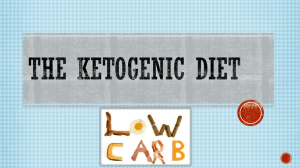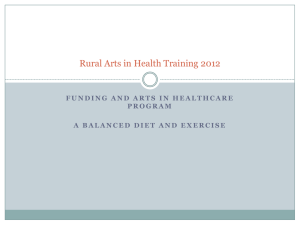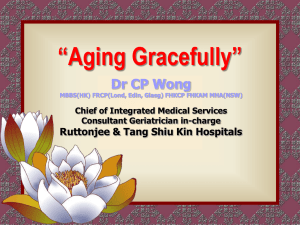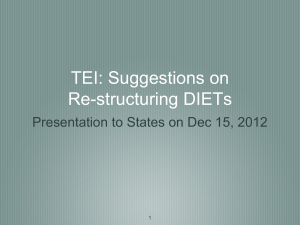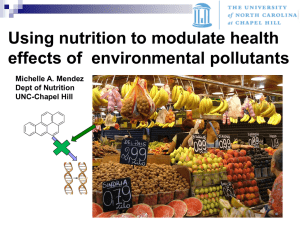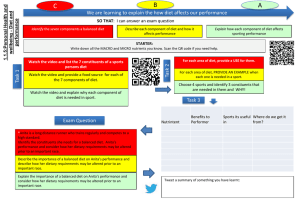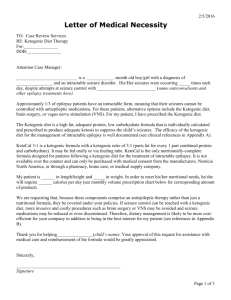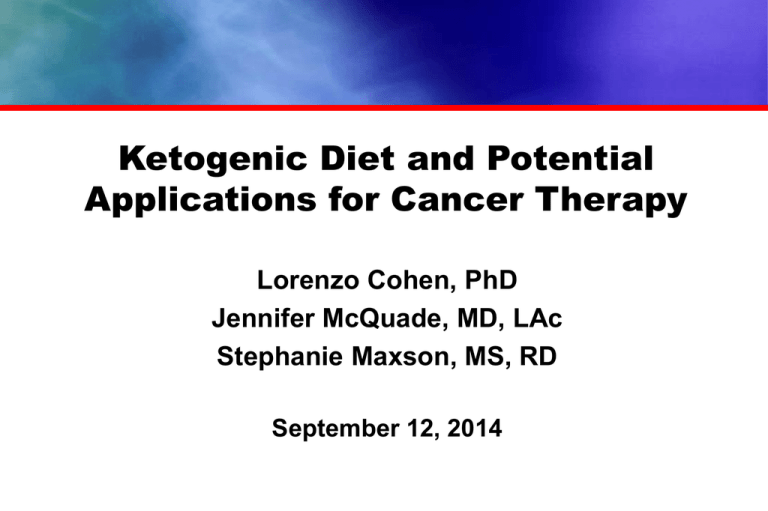
Ketogenic Diet and Potential
Applications for Cancer Therapy
Lorenzo Cohen, PhD
Jennifer McQuade, MD, LAc
Stephanie Maxson, MS, RD
September 12, 2014
Ketogenic Diet - History
•
•
•
•
Hippocrates recommended fasting for seizure therapy
First scientific publication – France, 1911
First efficacy studies of ketogenic diet for epilepsy – US 1925
Interest waned in 1938 with phenytoin, then renewed ~1990
Ketogenic Diet
• Composition:
– High fat
– Very low CHO (<50 gm/day)
– Adequate protein
• Increases reliance on fatty acids instead of glucose → mimics
fasting
• Low serum glucose during fasting triggers hormone changes
→ lipolysis
• Free fatty acids then converted to ketone bodies in liver
– acetoacetate and β-hydroxybutyrate
Indications
• Indications:
– Intractable epilepsy, all ages. Mechanism unknown.
– Inborn metabolic disorders ie. pyruvate dehydrogenase complex deficiency
• Experimental Uses:
–
–
–
–
–
DM type 2
PCOS
Autism
Bipolar disorder
Cancers, especially brain and skin
• Contraindications:
– Fatty acid oxidation defects
– Primary carnitine deficiency
Adverse Effects
• Short-term:
–
–
–
–
Hypoglycemia
Acidosis
Dehydration, poor appetite
Constipation, diarrhea
• Long-term:
–
–
–
–
–
Growth retardation
Micronutrient deficiencies
Hypertriglyceridemia
Renal stones
Irritability, lethargy
• Serious but rare:
– Acute pancreatitis
– Cardiomyopathy
– Acute hemolytic anemia
Diet Details
• KD typically 4:1 or 3:1
– gm fat : gm protein + gm CHO
– Lower ratios to better meet protein requirements or improve tolerance
– Compared to standard diet (25% fat, 20% protein, 55% CHO) → 1:6.7
• Menus are calculated to the nearest gram
• Foods weighed to the nearest 10th gm
• Typically includes high fat foods: heavy cream, sour cream, butter,
margarine, oil, mayonnaise
• Protein sources added second
• Very limited portions of CHO foods, including fruits and vegetables,
added last.
KD Mechanisms- Epilepsy
• Epilepsy– Metabolic changes likely related to the KD’s anticonvulsant properties include –
but are not limited to – ketosis, reduced glucose, elevated fatty acid levels, and
enhanced bioenergetic reserves. Direct neuronal effects induced by the KD may
involve ATP-sensitive potassium (KATP) channel modulation, enhanced purinergic
(i.e., adenosine) and GABAergic neurotransmission, increased brain-derived
neurotrophic factor (BDNF) expression consequent to glycolytic restriction,
attenuation of neuroinflammation, as well as an expansion in bioenergetic
reserves and stabilization of the neuronal membrane potential through
improved mitochondrial function.
– Direct role of ketones in decreasing neuronal excitation- “available evidence
thus far fails to strongly support a primary mechanistic role for ketone bodies”
SHORT ANSWER= WE DON’T KNOW
Fig. 4 Decreased metabolism of glucose by tumors, visualized by PET with the glucose analog FDG,
predicts response to anticancer therapy.
M G Vander Heiden et al. Science 2009;324:1029-1033
Published by AAAS
Fig. 2 Schematic representation of the differences between oxidative phosphorylation, anaerobic
glycolysis, and aerobic glycolysis (Warburg effect).
M G Vander Heiden et al. Science 2009;324:1029-1033
Published by AAAS
Fig. 3 Metabolic pathways active in proliferating cells are directly controlled by signaling pathways
involving known oncogenes and tumor suppressor genes.
M G Vander Heiden et al. Science 2009;324:1029-1033
Published by AAAS
Klement 2014
Metabolic heterogeneity vs. inflexibility
• Differential stress response
– Particularly in brain
- Debarardinis- UTSW
- NSCLC- C13 infusion during surgery- both glycolysis and
tca inc relative to normal tissues- regional heterogeneityglycolysis correlates with compromised perfusion
-High OxPhos as mechanism of resistance
Calorie restriction vs. ketogenic diet
• Very little evidence for direct anti-tumor effect of
ketones
• Tolerability
Gastric cancer cell line 2312/87 relies on
glycolysis
In vivo study design
• 24 nude mice-> 12 KD + 12 SD
• Cages of 6 animals
• Hind flank innoculation of gastric cancer cell line
2312/87
• Dietary intervention began same day as inoculation
• Ad libitum access to their diet
• Endpoint: Tumour volume 600 -700 mm3
• Survival time: Interval between subcutaneous
tumour cell inoculation and the endpoint
In vivo study design
•
•
•
•
•
•
•
•
•
40.7% curd cheese
19.9% mackerel
8.1% blue veined cheese,
8.1% white veined cheese
8.1% bacon
4.0% Tavarlin bread
MCT
21.45%
8.1% flaxseed
2.7% sesame seed
300 ml of Tavarlin oil (28.7% saturated fatty acids, 35.7%
unsaturated fatty acids, and 35.6% polyunsaturated fatty acids with
a ratio of omega-6/omega-3 of 1.77:1)
• 100 ml Tavarlin lactate drink
Ketogenic diet significantly decreases rate
of tumor growth
Ketogenic diet influences tumor “take”
Ketogenic diet significantly
prolongs“survival”
P=0.001
Impact on body weight, ketosis, glucose,
insulin
β-OHB levels :
1.3 ± 0.5 mmol/l KD
vs.
0.6 ± 0.1 mmol/l SD
(P < 0.001)
Glucose levels:
5.5 ± 2.7 mmol/l KD
vs.
6.3 ± 1.3 mmol/l SD
(P = 0.59)
Insulin levels:
63.3 ± 32.5 pmol/l KD vs.
72.0 ± 41.0 pmol/l SD
(P=0.84)
MCT KD anti-cancer, but why?
• Most studies of ketogenic diet are in fact studies of
calorie restricted ketogenic diet and evidence for CRKD
antitumor effects strong whereas mixed for ad libitum
KD
• Decrease in Insulin/IGF/Glucose more consistent in
calorie restriction studies
• Is it anti-tumor effects of the Omega-3’s and MCT?
• Anti-angiogenic
– good fats or reduced pyruvate-> dec HIF-1 activation of VEGF
– “Metabolic catastrophe”
The “Products”
ERGO: A pilot study of ketogenic diet in
recurrent glioblastoma
J. Rieger, O. Bahr, GD Maurer, et al.
International Journal of Oncology (2014)44:1843-52.
• Primary Objective: feasibility of ketogenic diet in
glioblastoma patients
• Secondary Objectives:
–
–
–
–
–
Diet safety
Percentage of patients achieving ketosis
Quality of life
Progression-free survival
Overall survival
Human Study
• Prospective, open-label, single-arm pilot
• Inclusion criteria:
– Age ≥ 18yo
– Relapse ≥ 6 months after initial surgery AND ≥ 3 months
after completion of radiation
– Relapse during OR after temozolomide
– No other reasonable chemo options OR chemo refused
– Karnofsky performance score (KPS) ≥ 60%
• Exclusion criteria:
– DM requiring insulin OR cardiac insufficiency
- 12.5 months – median time from dx to start of study
treatment (6-42 mos.)
Ketogenic Diet
• 60 grams CHO/day → estimated 1.4:1
• No calorie restriction
– Instructed to eat to satiety
• Fermented yogurt drink: 500ml/day
• 2 plant oils:
– “basic” oil and “addition” oil (99% fat)
• No standardized meal plan
– Instructed on keto diet
– Provided recipes and written instructions
– Subjects prepared own meals
Data Collection
• Assessed at baseline, follow-ups (6-8 week intervals), and
clinical progression :
–
–
–
–
seizures, medications, vitals
Glu, HbA1c, triglycerides, cholesterol, LDL, HDL
KPS, mini-mental status, QOL questionnaire
Neurological examination
Data Collection (cont)
• Subjects collected:
– Urine ketones 2-3 times per week
– “Nutritional plan”
• Weekly questionnaire (scale of 0-3):
– Diarrhea/constipation
– Hunger
– Glucose demand
• MRI: q6-8 weeks or with clinical progression
– Response or stable → continue diet
– Progression → “allowed” to continue diet with salvage therapy
– Progression with combination → diet discontinued
- 20 subjects enrolled (12/07-3/10)
Safety/Tolerability
• Followed diet avg 6.8 days/wk
• No serious adverse events
• Majority w/ no const./diarrhea
• Hunger first week but improved
following weeks
Efficacy
For all subjects:
• Median time to progression:
5 weeks (3-13)
• Median overall survival after
start of diet: 32 weeks
(6-86+)
• Trend for longer PFS in
subjects with stable ketosis
(>50%)
Efficacy (cont)
• Progression in all 17 subjects
• 7 continued diet with bevacizumab salvage therapy
– 1 complete response and 5 partial responses
→ Overall response of 85%
– compared these subjects to a cohort of 28 patients treated with
bev at same institution without ketogenic diet- ORR 65% (p=0.4).
These response rates are both significantly higher than those
reported in the Phase II trials of bev salvage (28-40%)
Efficacy (cont)
• Median PFS from bev:
– with keto diet: 20.1
weeks (12-124)
– without keto diet: 16.1
weeks (4-90+) (p=0.38,
95% CI 15-17wk)
Mouse Study
• Does keto diet modulate the efficacy of bevacizumab?
• Pilot study combining keto diet with bev in mice
– 44 female, athymic mice
– Glioma cells implanted into right striatum
– ad lib food and water
– randomized to standard CHO-rich diet OR keto diet (3.14:1)
– twice weekly intraperitoneal injections of bev OR saline
(starting day 12)
Methods
• Day 24, 5-7 animals per group: β-hydroxybutyrate
• Day 28, 3 animals per group:
– tumor measured by MRI
– bioluminescence imaging to map concentrations:
• ATP
• lactate
• glucose
• Remainder sacrificed at onset of symptoms OR loss of
>20% weight
• KD alone had no effect on survival.
• Combined bev and KD prolonged survival significantly compared
to bev alone
• Tumor volume tended to be smaller with combination bev and KD
(p<0.05)
• Bev sig. reduced ATP in tumor tissue; trend for stronger effect in
mice fed KD
Conclusion
• Keto diet is feasible and safe, but probably has no significant
clinical activity when used as single agent in recurrent glioma.
Discussion:
• Diets poorly monitored and documented
• Diet ratio moderately ketogenic
• CHO limits not individualized
• No sig change in glucose; related to steroids?
Discussion
•
•
•
•
•
Ketogenic versus calorie restriction?
Feasibility of maintaining a ketogenic diet?
Role of specific fats – any fat or ideal to have MCT?
Is it the high fat that matters or just low carbs/GL?
More relevant for some cancers (e.g., brain)?

